
To illustrate a typical IFR flight sequence of control, follow an imaginary trip from Will Rogers World Airport, Oklahoma City, Oklahoma to Washington National Airport, Washington, D.C.
Figure 11-1. IFR - Oklahoma City to Washington D.C.
 |
You, as pilot of FASTFLIGHT 5432K, have filed the flight plan either in person or by telephone with the Oklahoma City FSS, giving the information necessary for the Center to coordinate the flight with other IFR traffic. (At airports where no FSS is available, the flight plan may be filed by telephone to an FSS, ATC tower, or ARTCC.) The flight plan should be filed at least 30 minutes prior to the estimated time of departure to preclude possible delay in receiving the departure clearance from ATC. An IFR flight plan can be filed by radio with an FSS after takeoff if VFR conditions are maintained. This is less desirable than filing in person or by telephone.
Figure 11-2. Filing the flight plan.
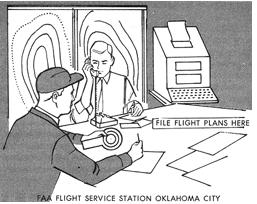 |
After the flight plan has been filed, the OKC FSS transmits pertinent flight plan data by interphone or teletype to the Fort Worth Air Route Traffic Control Center where it is entered into a computer.
Figure 11-3. Copying the clearance.
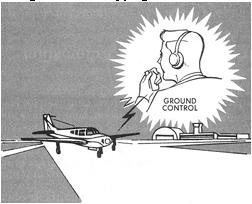 |
Prior to taxiing, you should call clearance delivery and request IFR clearance. If there is to be no delay, you will normally be advised at this time. An airport such as Will Rogers, which has "Pre-taxi Clearance Procedures" will probably have your clearance and issue it to you immediately. You could expect your clearance to be issued in the "abbreviated departure clearance" format as follows:
FASTFLIGHT FIVE FOUR THREE TWO KILO - CLEARED TO WASHINGTON
NATIONAL AIRPORT AS FILED - FLY RUNWAY HEADING - CLIMB AND
MAINTAIN FIVE THOUSAND EXPECT SEVEN THOUSAND ONE ZERO MINUTES
AFTER DEPARTURE - DEPARTURE FREQUENCY WILL BE ONE TWO FOUR
POINT TWO - SQUAWK ZERO FOUR ONE FOUR.
You should copy the clearance and read it back. This clearance was originated in the Fort Worth Center and the clearance delivery controller is merely relaying it to you. However, certain restrictions may be added as required by the Oklahoma City departure controller.
Figure 11-4. Cleared for departure.
 |
After receipt and acknowledgment of the IFR clearance, you should contact ground control and request taxi clearance to the runway in use.
After engine run-up, you should change to tower frequency (118.3 MHz) and advise that FASTFLIGHT five four three two KILO is ready for takeoff. The tower issues the following clearance:
FASTFLIGHT FIVE FOUR THREE TWO KILO - CLEARED FOR TAKEOFF.
After takeoff, the tower controller notifies the Oklahoma City
departure controller that FASTFLIGHT 5432K has departed and the pilot will
be directed to contact departure control. The departure controller will
radar identify the aircraft and issue further instructions to provide separation
from other aircraft in the terminal area and establish it on the flight
plan route.
FASTFLIGHT FIVE FOUR THREE TWO KILO - OKLAHOMA CITY DEPARTURE
CONTROL - RADAR CONTACT - FLY HEADING ZERO FOUR ZERO TO
INTERCEPT VICTOR FOURTEEN SOUTH - CLIMB AND MAINTAIN SEVEN THOUSAND.
The phrase, "TO INTERCEPT VICTOR FOURTEEN SOUTH," indicates that you should resume normal navigation upon intercepting the airway, without further clearance. In absence of instructions, "TO INTERCEPT," you should maintain the last assigned heading even though it takes the aircraft through V14S. It is possible that departure control is using this means to provide separation from other aircraft. Normally, the controller would advise, "FASTFLIGHT FIVE FOUR THREE TWO KILO FLY HEADING ZERO FOUR ZERO FOR VECTORS EAST OF VICTOR FOURTEEN SOUTH TO PASS TRAFFIC TEN O'CLOCK SIX MILES SOUTHBOUND, BARON, FIVE THOUSAND."
As 5432K departs the terminal area, you are advised to contact Fort Worth Center on a specified frequency. Since the aircraft has been radar identified, the initial call would be:
FORT WORTH CENTER - FASTFLIGHT FIVE FOUR THREE TWO KILO -
LEAVING FIVE THOUSAND.
Fort Worth Center replies:
FASTFLIGHT FIVE FOUR THREE TWO KILO - REPORT LEAVING SIX THOUSAND.
Figure 11-5. En route control.
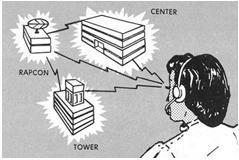 |
Since 5432K is operating in a radar environment, and has been
advised "radar contract," the only reports required would be those specifically
requested by the controller. However, each time the aircraft is changed
to a different control facility, or to a different sector within a facility,
you should report altitude on the initial call.
If advised, "RADAR CONTRACT LOST" or "RADAR SERVICE TERMINATED,"
you should resume normal position reporting procedures. See the AIRMAN'S
INFORMATION MANUAL under "Enroute - IFR."
Figure 11-6. Position report.
 |
As the flight progresses along airways, the flight data information is passed along from sector to sector within each Center, and from Center to Center along the route. Each controller receives advance notification of this flight and determines if there is any conflict with traffic within the sector. Each controller is responsible for issuing control instructions which will provide standard aircraft separation. This may be accomplished by route changes, altitudes changes, requiring holding, or providing radar vectors off course.
As the flight enters the Washington Terminal area, the Center controller will effect what is known as a "Radar Handoff" to Washington approach control. This is a method whereby one controller points out a target to another controller and thereby passes on the identity and control responsibility without an interruption in radar service. In the absence of a "Radar Handoff," it would be necessary for the approach controller to use one of several other means of identifying the aircraft, such as identifying turns, position reports, or transponder.
When both controllers are satisfied with the identification of 5432K, you will be advised to contact Washington approach control on a specified frequency.
Figure 11-7. Positive identification by approach control.
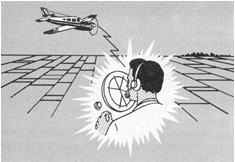 |
Prior to this frequency change, you should have determined that ATIS (Automatic Terminal Information Service) is available at Washington National Airport, and should have tuned in the proper frequency and listened to the information. If you have received the ATIS broadcast, approach control should be so advised. The ATIS provides all the necessary approach, runway, NOTAM, and other pertinent information for landing at Washington National. The controller need provide only necessary control instructions. Your initial call to Washington approach control would be:
WASHINGTON APPROACH CONTROL - FASTFLIGHT FIVE FOUR THREE TWO
KILO - SEVEN THOUSAND - INFORMATION BRAVO.
The approach controller's action now depends on the conditions and traffic at the airport. If no approach delay were expected, the reply to 5432K would be:
FASTFLIGHT FIVE FOUR THREE TWO KILO - WASHINGTON APPROACH
CONTROL - FLY HEADING ONE TWO ZERO FOR VECTORS TO FINAL
APPROACH COURSE - DESCEND AND MAINTAIN THREE THOUSAND.
(NOTE: ATIS information BRAVO advised that ILS approach to runway 36 would be expected.)
Figure 11-8. ILS approach.
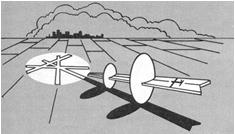 |
The approach controller will now provide radar navigation to position your aircraft so as to intercept the final approach course prior to the outer marker. You will be advised to descend in sufficient time to reach the proper glide path interception altitude. Your clearance for an ILS approach will be issued when the controller has provided proper spacing between 5432K and other aircraft being controlled and when 5432K is on a course that will intercept the localizer, outside the outer marker, at not more than a 30° angle. This clearance follows:
FASTFLIGHT FIVE FOUR THREE TWO KILO - THREE MILES FROM OUTER
MARKER - MAINTAIN TWO THOUSAND FIVE HUNDRED UNTIL ESTABLISHED
ON THE LOCALIZER - CLEARED FOR ILS RUNWAY THREE SIX APPROACH
- CONTACT TOWER ON ONE ONE NINER POINT ONE.
(NOTE: You should not turn onto the localizer unless this clearance is received).
You should now turn on the localizer when you intercept it and complete the approach to a landing or to the "MISSED APPROACH POINT."
If traffic conditions at Washington National required a delay,
the approach controller would have issued instructions to proceed to a
holding point and hold. This clearance would have been:
FASTFLIGHT FIVE FOUR THREE TWO KILO - WASHINGTON APPROACH
CONTROL - MAINTAIN SEVEN THOUSAND - PROCEED DIRECT TO ARMEL
VORTAC - HOLD WEST OF ARMEL ON VICTOR FOUR - EXPECT FURTHER
CLEARANCE AT ONE ONE THREE FIVE.
At the appropriate time, 5432K would have been instructed to depart ARMEL on a specified heading and would have been vectored to final approach as in the preceding example.
Figure 11-9. Stacking.
 |
After the approach and landing is completed, unless otherwise instructed, proceed in the landing direction to the nearest turn-off and exit the runway without delay. Do not change to ground control frequency while on the active runway unless so instructed by the tower.
Figure 11-10. Cleared to land.
 |
In summary, the foregoing picture of an IFR flight illustrates
the need for adherence to carefully established procedures for safe, orderly,
and expeditious traffic flow. The pilot and controller must know what to
expect of each other, as well as knowing the details of their own special
authority and responsibility. The controller, for example, must be aware
of the performance capabilities of the various aircraft operating in the
system in order to issue clearances and instructions with which the aircraft
are capable of complying. Likewise, the instrument pilot should understand
the overall traffic problem and the standardized IFR control procedures
in order to avoid being unprepared by an unexpected request or change in
clearance. In fact, the experience instrument pilot can usually anticipate
what the controller will say. During periods of heavy traffic conditions,
when clearances seem complicated and unduly restrictive, the utmost cooperation
between the pilot and the controller is especially required.